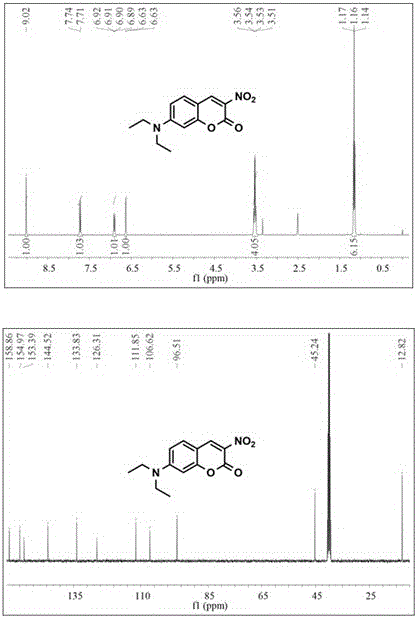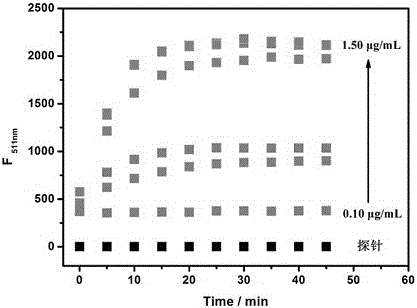Double-photon fluorescent probe capable of fast detecting nitroreductase
A two-photon fluorescence and reductase technology, applied in the field of fluorescent probes and organic small molecule fluorescent probes, can solve the problems of low sensitivity, long response time, background interference, etc.
- Summary
- Abstract
- Description
- Claims
- Application Information
AI Technical Summary
Problems solved by technology
Method used
Image
Examples
Embodiment 1
[0026] Compound CNO 2 -Synthesis of HY
[0027] In a 100 mL round bottom flask, add 10 mmol 4-diethylamino salicylaldehyde and 30 mL n-butanol, add 11 mmol ethyl nitroacetate while stirring at room temperature, then add 0.15 mL piperidine and 0.3 mL ice dropwise Acetic acid. The reaction system was heated to reflux for 12 hours and then cooled to room temperature, filtered under reduced pressure, and the filtrate was recrystallized with ethanol to obtain the product, named: 3-nitro-7-diethylaminocoumarin, abbreviated as CNO 2 -HY, the yield is 77%. 1 H NMR spectrum and 13 The C NMR spectrum is shown as figure 1 .
[0028] 1 H NMR (400 MHz, DMSO- d 6 ): 9.02 (s, 1H), 7.72 (d, J = 9.2 Hz, 1H), 6.91 (dd, J 1 = 9.2 Hz, J 2 / = 2.4 Hz, 1H), 6.63 (d, J = 2.4 Hz, 1H), 3.53 (q, J = 7.2 Hz, 4H), 1.15 (t, J = 7.2 Hz, 6H); 13 C NMR (400 MHz, DMSO- d 6 ): 158.86, 154.97, 153.39, 144.52, 133.83, 126.31, 111.85, 106.62, 96.51, 45.24, 12.82.
Embodiment 2
[0030] Compound CNO 2 -HY two-photon hypoxia fluorescence probe absorption spectrum test
[0031] Prepare 1 part of 5 mL of 1 mM two-photon fluorescent probe CNO for detecting nitroreductase of the present invention 2 -HY in dimethyl sulfoxide (DMSO) solution. Take 25 μL of the probe mother solution and add them to two identical 5 mL volumetric flasks, add 225 μL of DMSO solution, and add nicotinamide adenine dinucleotide (NADH) 500 μM to both. One of them was added with phosphate buffer solution (10 μg / mL, 500 μL) of nitroreductase, and the other was not added. Both volumetric flasks were made up to 5 mL with phosphate buffered saline (PBS, pH = 7.4), incubated at 37°C for 45 minutes, and then subjected to absorption spectrum test. See the result figure 2 Probe CNO 2 -The absorption curve of HY in phosphate buffered solution (PBS). The probe concentration is 5 μM. (a): Absorption curve of the probe itself; (b): Absorption curve of the probe and 0.75 μg / mL nitroreductase for...
Embodiment 3
[0033] Compound CNO 2 -HY Two-photon Hypoxia Fluorescent Probe and Nitroreductase Kinetic Test
[0034] Prepare 5 mL of an aqueous solution with a concentration of 10 μg / mL nitroreductase and a mother solution of the two-photon fluorescent probe for detecting nitroreductase in the hypoxic region of the present invention with a concentration of 1 mM as a spare. Prepare solutions of probe and nitroreductase, the concentrations of which are: probe 5 μM; nitroreductase: 0, 0.1, 0.25, 0.5, 0.75, 1.5 μg / mL. Perform fluorescence detection (λ ex = 450 nm, λ em = 511 nm), test every 5 minutes, test for 45 minutes, record the fluorescence intensity of each system over time, and establish a standard curve of fluorescence intensity over time. Such as image 3 As shown, after 20 minutes of reaction, the fluorescence intensity of the reaction system reached saturation. Therefore, 20 min can be taken as the reaction time. image 3 The probe concentration is 5 μM, the nitroreductase concentra...
PUM
 Login to View More
Login to View More Abstract
Description
Claims
Application Information
 Login to View More
Login to View More - R&D
- Intellectual Property
- Life Sciences
- Materials
- Tech Scout
- Unparalleled Data Quality
- Higher Quality Content
- 60% Fewer Hallucinations
Browse by: Latest US Patents, China's latest patents, Technical Efficacy Thesaurus, Application Domain, Technology Topic, Popular Technical Reports.
© 2025 PatSnap. All rights reserved.Legal|Privacy policy|Modern Slavery Act Transparency Statement|Sitemap|About US| Contact US: help@patsnap.com



